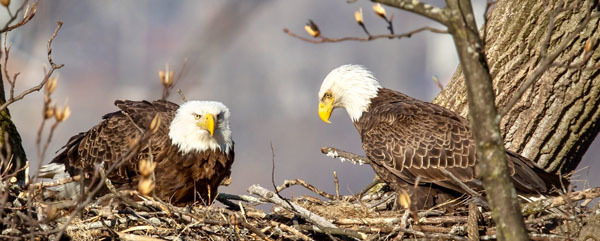Hudson River Almanac 3/23/19 - 3/29/19
The New York State Department of Environmental Conservation sent this bulletin on 04/05/2019 02:00 PM EDT |
| DEC Delivers - Information to keep you connected and informed from the NYS Department of Environmental Conservation |
| Share or view as a web page || Update preferences or unsubscribe |
Hudson River Almanac
|
Compiled by Tom Lake, Hudson River Estuary Program Consulting NaturalistOverviewThis was a week of Highlight; choosing just one was a challenge. The onset of a new season of bald eagle nestlings barely bested another Hudson River seal sighting. The estuary’s glass eel nets were already producing high numbers. Highlight of the Week3/24 – Town of Poughkeepsie: There was exciting news today at bald eagle nest NY62. We watched the adult male bring a gizzard shad to the nest this morning, a reliable sign that there was another mouth to feed. From an appropriate distance through our strong optics, we watched multiple feedings: there was a nestling! [Bob Rightmyer had guessed that eggs were laid on February 22, and today made it 31 days (average 32-35 days). A second nestling was discovered two days later, 3/26, hatching after 33 days These two brought the NY62 total to 20 nestlings across 19 years (2001-2019). The female of this pair has had legendary success. Tom Lake] Natural History Entries3/23 – Town of Saugerties, HRM 102: I heard my first spring peeper of the season this afternoon, vocalizing from the marsh at the New York State Great Vly Wildlife Management Area. Later, I heard several peepers in the wetlands at the Esopus Bend Nature Preserve. Still no quacking wood frogs in the vernal pools, however. 3/23 – Poughkeepsie, HRM 75.5: The glass eel migration in the Fall Kill was progressing steadily. Several days of no glass eels followed the fyke net installation, but as the water warmed, a few began to show up. Then, yesterday we collected 200 and today 618. Part of our analysis of the glass eel run is to measure 20 eels each day to document changes in their weight. Today’s 20 glass eels weighed 4.1 grams.
3/23 – Bedford, HRM 35: The great blue heron rookery now had 14 occupied nests. Three nests had a pair of herons standing on the rim. Eleven nests had a single heron; most were standing, but six were settled down in the nest possibly sitting on eggs. Eggs are laid at two-day intervals, with incubating beginning with the first egg. Both herons incubate the eggs, with one sitting on the eggs while the other is out hunting. They switch duties when one returns and the other one goes off to hunt. There are several unoccupied nests, and the winter storms seemed to have knocked down some of the nests as well. The hardwood trees holding the nests eventually die as a result of water levels rising in the swamp. Herons prefer to nest in rookeries with as many as a hundred nests. 3/23 – Croton-on-Hudson, HRM 34.5: The osprey nest we have dubbed the “Cell Tower Nest,” near the Croton train station, had one osprey there this morning. Its mate had not yet arrived for their breeding season. Last year they were both on station on April 3. A slew of crows was mobbing the fish hawk as it perched on a nearby stanchion. The osprey appeared unperturbed. This will be this pair’s seventh season at the cell tower nest. [This encounter reminded me of this time last year when the nest was being refurbished, and crows were pulling sticks out of the nest, flying off, and dropping them a hundred yards away. The osprey’s cleverness as well as territorial paranoia of crows was on full display. Tom Lake] 3/23 – Croton River, HRM 34: I found four green-winged teal in the tidemarsh behind the Metro North station parking lot this morning. There was also a Wilson’s snipe and an estimated 1,000 tree swallows. 3/24 – Minerva, HRM 284: I collected three gallons of maple sap yesterday. It is running very slowly (as our local commercial operations will attest). Hopefully, some cold nights-warm days to come will help. Our first red-winged blackbirds are now here as well, and skeins of returning Canada geese have been passing over.
[Rich Guthrie’s harbor seal was a young female, about four-years-old. Kimberly Durham, Atlantic Marine Conservation Society] 3/24 – Four Mile Point, HRM 121: We visited the Vosburgh Swamp Wildlife Management Area this morning where we counted 40 bird species. The Vosburgh swamp was mostly open except for a skim of ice in the shallows. Waterfowl were present in good numbers, including common merganser, hooded merganser, American black duck, green-winged teal, wood duck, American wigeon, ring-necked duck, gadwall and Canada goose. A northern harrier made a pass over the marsh shortly after we got there, temporarily putting up most of the ducks. On the river, we had a group of lesser scaup and the expected bald eagles (3). We heard what sounded like, but not quite, spring peepers. The vocalizations were actually green-winged teal. 3/24 – New Paltz, HRM 78: Just after dark, I heard two spring peepers calling. But surely there’s more to come, along Old Kingston Road in New Paltz. 3/24 – Beacon, HRM 61: Today, a constant 20 mile-per-hour west wind in my face had me bundled up and burning through three packages of hand-warmers, making carp fishing a challenge. While the action was slow, I managed to catch my first fish of the season (my only bite of the day). After sitting quietly on the rod-rest for more than three hours, my reel began screaming as a carp (8.0 pounds 12 ounces) latched onto my bait and took off for mid-river. The river was 41 degrees Fahrenheit (F). 3/25 –Ulster County HM 91.5: I counted at least five horned grebes, all in different phases of getting 3/25 – Wappinger Falls, HRM 68: We had an exciting week of fox sightings. We watched a female red fox dash right by our bird feeders four times today in pursuit of gray squirrels. Twice, she climbed a few feet up a large lilac shrub after a squirrel. She appeared to be heavily pregnant with a large belly and that probably did not aid her in the hunt. 3/26 – Kingston, HRM 92: The gulls at Kingston Point kept me entertained and shooting images today. One ring-billed gull came up with a small channel catfish, and the chase was on as other gulls followed in hot pursuit. 3/26 – Putnam County, HRM 54: Wood frogs were calling from a vernal pool in Hudson Highlands State Park Preserve (Nelsonville) today. The pool, completely thawed, also had a pair of wood ducks. A nearby pool was still frozen.
3/26 – Manhattan, HRM 2: Our eel mop is deployed outside of The River Project’s Wetlab on Pier 40 and is set to capture glass eels coming in from the sea. The eel mop did well this week with other fishes as well. They included two immature naked gobies (25-30 millimeters (mm)) and an immature back sea bass (25 mm). [Eel mops are a basketball-sized tangle of polypropylene tentacles placed in the river and found by glass eels to be a very cozy way-station on their trip upstream. The mop can be lifted out, shaken, and glass eels will fall into a waiting bucket. The Atlantic State Marine Fisheries Commission literature has the perfect name for the mops: Medusa device. Medusa was a priestess in Greek mythology. In a fit of anger, the Greek goddess Athena, daughter of Zeus, transformed Medusa’s hair into a head of snakes. As the eel mop gyrates in the current, it conjures that image. Tom Lake] [Note: one inch = 25.4 millimeters (mm)] 3/26 – Manhattan, HRM 1: We made our weekly check this afternoon on our research sampling gear in Hudson River Park at The River Project's sampling station on the lighthouse tender Lilac at Pier 25 and found what has been the usual assemblage of invertebrates that populate the inner pier area of Manhattan’s west side. They included shore shrimp, mud dog whelks, isopods, and mud crabs.
[Some things we know: These common slipper shells cannot be fossils; they were recently-alive shellfish. According to the literature, the common slipper shell (Crepidula fornicata) is a sedentary, filter-feeding sea snail or marine gastropod, native to the east coast of North America ranging from Canada south to Florida. They are strictly saltwater mollusks with no documented affinity for low salinity or freshwater. It has been theorized that they could be a dump from a seashell collection or even just the aftermath from a visit to the seashore. Other ideas include transportation and dump by a shipping vessel, falling off scientific gear used in saltwater, and escapees from the shells of horseshoe crabs used for blue crab bait. Or alternatively, these common slipper shells are, however unlikely, violating their scientific literature. Tom Lake]
3/27 – Norrie Point, HRM 85: Is it possible that I just saw a little eaglet moving around in bald eagle nest NY142 across the Hudson River from Norrie Point? [I have noted that the adults in bald eagle nest NY142 began seriously tending to the nest since February 6. If that date is close to the actual start of incubation, a hatch would be expected by March 9-12. The adults in NY142 had been busy in and out of the nest since March 20, which would fit well with the possible hatch dates. A March 12 hatching would yield a 15-18-day-old nestling, and that would fit Chris Bowser’s observation as well. Dave Lindemann]
[When red foxes are hungry, they can almost sprout wings. The tale of the “tree-climbing” red foxes reminds us of their relative, the gray fox (Urocyon cinereoargenteus). With special adaptations, gray foxes are the only dog (canid) that can climb a tree, albeit not with the skill of an opossum. Tom Lake] 3/28 – Fort Miller, HRM 192: Just south of Fort Miller (Lock 6), I found a small group of returning snow geese including two “dark morphs.” [Dark morph, or blue goose, is a color phase of snow geese.) 3/28 – Saratoga County, HRM 173: After reading several reports from Wrights Loop North over the past few days, I made a visit there this afternoon. The western half of the field was covered by a large vernal pool and was chock full of waterfowl. Among the 18 species I counted were Canada goose (76), wood duck (75), American wigeon (42), mallard (365), American black duck (44), northern pintail (47), and green-winged teal (29). Two killdeer were working the edge of the field. 3/28 – Haverstraw Bay, HRM 36: Our DEC Hudson River Fisheries Unit crew was on Haverstraw Bay today gill-net sampling for immature sturgeon, and we were surprised to catch a white catfish (Ameiurus catus). We have seen a decline in white catfish numbers in our nets over time, being replaced by channel catfish. To us it appears that the invasive catfish occupies a broader ecological niche providing a competitive advantage. We took a piece of spine from the fish to help us learn more about the age structure and size-at-age of the fish we captured. [The white catfish is a native species (it was here in 1609); the channel catfish (Ictalurus punctatus) is an invasive species, a twentieth century canal immigrant from the Midwest. From 1985 through 2001, white catfish comprised more than 99 percent of the DEC Fisheries Unit's haul seining catfish by-catch from our annual study of American shad and striped bass spawning stocks. However, beginning in 2003, the percentage of white catfish decreased from 81 percent in 2003 to 15 percent in 2009. At the same time, channel catfish increased from 19 percent in 2003 to 85 percent in 2009. It is unclear if they are direct competitors or if something else is accounting for the drastic change in abundance. - Kris McShane] *** Fish of the Week ***
Naked gobies are small estuarine fish, usually less than 75 (mm) long, found in shallow, sandy inshore areas of the lower estuary. They lack scales on their body, hence the common name "naked." Their pectoral fins form a disk on their abdomen and when kept in aquaria, will often "stick" themselves to the side of the glass. In the distant past, when the river had extensive oyster beds – their preferred habitat – it is likely that the naked goby was much more common. (Photo of naked goby courtesy of The River Project) Spring-Summer 2019 Natural History ProgramsSaturday, April 27 (8:00 AM - 12:00 PM.. or later) Wednesday, July 10 - Thursday July 11 (9:00 AM - 5:00 PM) Tuesday, August 20 - Thursday August 22 (9:00 AM - 4:00 PM) Volunteer Opportunity: Hudson River Eel Project Hudson River: Striped Bass Cooperative Angler Program Here’s how it works: Fill out a logbook provided by us whenever you fish on the Hudson River (by boat or from shore). Record general location, time, gear used, what you caught (or if you didn’t catch anything) and return the logbook when you are done fishing for the season. You’ll receive an annual newsletter summarizing the information in addition to the latest news regarding regulations and the river. Whether you catch-and-release or take home a keeper, you can be part of the Cooperative Angler Program. Hudson River MilesThe Hudson is measured north from Hudson River Mile 0 at the Battery at the southern tip of Manhattan. The George Washington Bridge is at HRM 12, the Tappan Zee 28, Bear Mountain 47, Beacon-Newburgh 62, Mid-Hudson 75, Kingston-Rhinecliff 95, Rip Van Winkle 114, and the Federal Dam at Troy, the head of tidewater, at 153. The tidal section of the Hudson constitutes a bit less than half the total distance – 315 miles – from Lake Tear of the Clouds to the Battery. Entries from points east and west in the watershed reference the corresponding river mile on the mainstem. To Contribute Your Observations or to SubscribeThe Hudson River Almanac is compiled and edited by Tom Lake and emailed weekly by DEC's Hudson River Estuary Program. Share your observations by e-mailing them to trlake7@aol.com.
|

 3/23 – Galeville, HRM 74: On a visit to the Shawangunks Grasslands National Wildlife Refuge today, I was treated to dueling short-eared owls. (Photo of short-eared owls courtesy of Terry Hardy)
3/23 – Galeville, HRM 74: On a visit to the Shawangunks Grasslands National Wildlife Refuge today, I was treated to dueling short-eared owls. (Photo of short-eared owls courtesy of Terry Hardy) 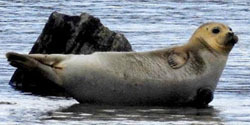 3/24 – New Baltimore, HRM 131.5: In late afternoon just before high tide, I came upon a harbor seal hauled out on a large riverside rock. The seal was reclined in its “banana” pose, a normal posture that suggests, incorrectly to some observers, that the seal is in distress. I quickly went up and got Pete and Maggie Zacek down in time to see the seal before the tide rose high enough to reach the rock where she was resting (when the tide reaches them, they usually slip back into the water). (Photo of harbor seal courtesy of Richard Guthrie)
3/24 – New Baltimore, HRM 131.5: In late afternoon just before high tide, I came upon a harbor seal hauled out on a large riverside rock. The seal was reclined in its “banana” pose, a normal posture that suggests, incorrectly to some observers, that the seal is in distress. I quickly went up and got Pete and Maggie Zacek down in time to see the seal before the tide rose high enough to reach the rock where she was resting (when the tide reaches them, they usually slip back into the water). (Photo of harbor seal courtesy of Richard Guthrie)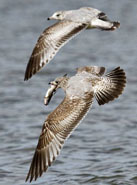 3/26 – Town of Poughkeepsie: The adults at bald eagle nest NY62 have two new mouths to feed (see 3/24) and have been very obliging in displaying the menu as they pass by from the river with fish for the nestlings. So far, the fish-of-the-day has included goldfish, gizzard shad, and channel catfish, all non-native species (these fish were not here in 1609). (Photo of ring-billed gulls courtesy of Terry Hardy)
3/26 – Town of Poughkeepsie: The adults at bald eagle nest NY62 have two new mouths to feed (see 3/24) and have been very obliging in displaying the menu as they pass by from the river with fish for the nestlings. So far, the fish-of-the-day has included goldfish, gizzard shad, and channel catfish, all non-native species (these fish were not here in 1609). (Photo of ring-billed gulls courtesy of Terry Hardy)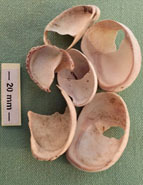 3/27 – New Baltimore, HRM 131.5: I went to the river today at Mrs. Sherman’s Beach looking for Rich Guthrie’s harbor seal, with no luck. But, I did find two more common slipper shells along the stretch of beach where I have found them before. [Last September, Kelly Halloran found a slipper shell on Mrs. Sherman’s Beach. That made five altogether that she had collected strewn across the sand, eroded by the tide. In November, she found many more. But where did they come from?] (Photo of common slipper shell courtesy of Tom Lake)
3/27 – New Baltimore, HRM 131.5: I went to the river today at Mrs. Sherman’s Beach looking for Rich Guthrie’s harbor seal, with no luck. But, I did find two more common slipper shells along the stretch of beach where I have found them before. [Last September, Kelly Halloran found a slipper shell on Mrs. Sherman’s Beach. That made five altogether that she had collected strewn across the sand, eroded by the tide. In November, she found many more. But where did they come from?] (Photo of common slipper shell courtesy of Tom Lake) 3/27 – Ulster County, HRM 85: I stopped by Sturgeon Pool this morning looking for waterfowl. I spotted a large bird approaching that I took for a great blue heron. However, the wing motion looked different. As it started to circle me overhead, I saw that it was a sandhill crane. The big bird headed up toward Kingston, then down the Rondout Creek, looking like it wanted to land. (Photo of sandhill crane courtesy of Jim Yates)
3/27 – Ulster County, HRM 85: I stopped by Sturgeon Pool this morning looking for waterfowl. I spotted a large bird approaching that I took for a great blue heron. However, the wing motion looked different. As it started to circle me overhead, I saw that it was a sandhill crane. The big bird headed up toward Kingston, then down the Rondout Creek, looking like it wanted to land. (Photo of sandhill crane courtesy of Jim Yates) 3/27 – Wappinger Falls, HRM 68: Our female red fox was back from her unsuccessful squirrel hunt two days ago. Today, I spotted her about ten feet up a small maple tree, after which she jumped down and strolled around our yard. Later, I saw her feasting on a gray squirrel. She ate what she wanted, finally burying the tail and marking the spot. (Photo of red fox courtesy of Melissa Fischer)
3/27 – Wappinger Falls, HRM 68: Our female red fox was back from her unsuccessful squirrel hunt two days ago. Today, I spotted her about ten feet up a small maple tree, after which she jumped down and strolled around our yard. Later, I saw her feasting on a gray squirrel. She ate what she wanted, finally burying the tail and marking the spot. (Photo of red fox courtesy of Melissa Fischer)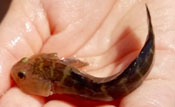 3/29 – Hudson River Watershed: This week’s fish is the naked goby (Gobiosoma bosc), a seasonally resident marine species. The naked goby is number 207 (of 228) on our watershed list of fishes. If you would like a copy of our list, e-mail:
3/29 – Hudson River Watershed: This week’s fish is the naked goby (Gobiosoma bosc), a seasonally resident marine species. The naked goby is number 207 (of 228) on our watershed list of fishes. If you would like a copy of our list, e-mail: 